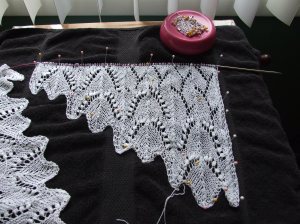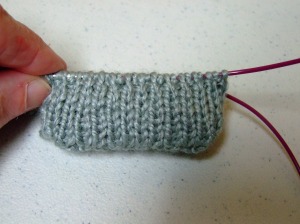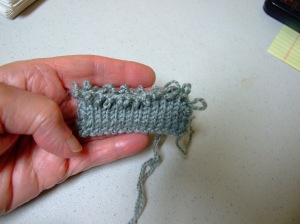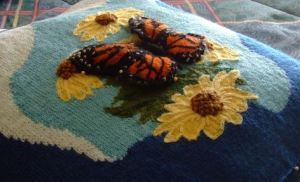As I was contemplating the possibility of beginning on one of my latest pillow designs, I thought it might be fun for me to share my thought process with you.
Below is a clip of the condensed chart, which gives me a view of “what you see is what you get,” with a 33 % view.
The design is from a simulated stain glass window that I created for my home in the mountains of Idaho. I painted the original on plexiglass then mounted it on the window of my kitchen door. The knitted design incorporates the frame, but I have added a South American butterfly to my Dogwood flowers, instead of the original Hummingbird.
 You will notice that there are 2 separate rings of colors surrounding the center motif. The first, or outside ring, shapes the pillow. The black edges will be knitted as part of the design. The technique I use for this is called Armenian knitting. I will be using 2 colors in each section and will be weaving the unused color in every other stitch. This will give me a bit of a textured look, simulating old rough glass. Any additional colors I might desire will be added using a single ply of the selected yarn, and applied as a duplicate stitch.
You will notice that there are 2 separate rings of colors surrounding the center motif. The first, or outside ring, shapes the pillow. The black edges will be knitted as part of the design. The technique I use for this is called Armenian knitting. I will be using 2 colors in each section and will be weaving the unused color in every other stitch. This will give me a bit of a textured look, simulating old rough glass. Any additional colors I might desire will be added using a single ply of the selected yarn, and applied as a duplicate stitch.
The second ring will also be knitted using the same technique, but this time the lines you see with be inserted after the work is finished. This will give me the option of using an embroidery stitch or crocheted chain to add this detail.
The center motif will be created using the Intarsia knitting technique described in my e-book.
To begin, I roll all my colors into small balls. Next, crochet thread, and crochet hook, I make a chain long enough to support the number of stitches on the bottom edge of row#1 on the chart, plus 10. Breaking the yarn, I leave a 6 inch tail, pull the yarn through and tied a loop in it. This chain provides me a base for my provisional cast on.
Turning this chain over to the back side, I count in 5 loops from the end before I start picking up the stitches of the first row, inserting the tip of my knitting needle in to the single back loop of each chain stitch. When all the necessary stitches have been placed on my knitting needle, row one of the chart has been completed.
The next row(purl) begins by adding a stitch. You can do this anyway you like. I will be using the following method: knit in front and back of same stitch at beginning and end of row for right side rows, then purl in back and front of stitches at beginning and end of purl rows. This gives me a more compact addition.
I can’t wait to see the results of my labor. Once I get started with one of these patterns, it is hard for me to put it down. I love seeing the picture develop, one row at a time.
I am going to drop this pillow top chart into my Designer Pillow page. You can also upload this 18 by 18 pillow top chart here.
stain glass pillow design chart
All the yarns are Palette by Knitpicks. The gauge is 9/12 using a #1 needle
One skein of each color is sufficient. You can also use fingering yarns from your stash. I have chosen to used “heathers” for the darkened areas, in the outside ring. I work with long strands of each color and spit splice yarn additions as needed.
I have not decided what kind of back I will create for this design, but there is plenty of time for that later. This is definitely not an overnight knitting project.
Below is a photo of what I see on my computer screen using my Pattern Maker Pro.
 If you have this program, then I can send you the actual file to work with.
If you have this program, then I can send you the actual file to work with.
The second photo is a shot that shows how I number the larger areas of stitches, which helps me to read the chart.

It may be a bit hard to see, but I have inserted the stitch count of the main color.
Happy knitting – KT
Read Full Post »


























